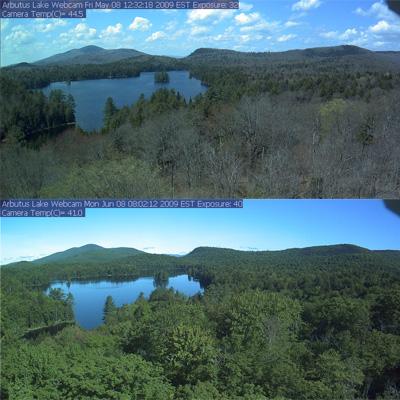Synthesis of Data from the PhenoCam Network: Phenological Controls on Forest Productivity

Phenology is the study of recurring events in nature that are influenced by seasonal environmental changes. Examples in deciduous forests are annual leaf production and leaf senescence, leading to leaf fall. Leaf activity controls tree growth or forest "productivity". Phenology helps to monitor effects of year-to-year climate variability and longer-term climate change, such as warming, on forest productivity.
To better document biological responses to a changing world, researchers, in a previous NSRC study, set up a “PhenoCam” using networked digital cameras, or webcams, at 12 research sites to monitor tree canopy phenology across New England, upstate New York, and adjacent Canada. Researchers use camera images to track phenology of canopy leaf development and senescence using computer modeling and image analysis. In this project, researchers used camera data, ground observations of leaf phenology, and measurements of forest productivity to answer basic questions about how phenology controls year-to-year variability in productivity across sites.
Researchers found that a 10-day longer growing season (due to earlier spring leaf out or delayed autumn leaf senescence) increased annual gross productivity by about 10% and annual net carbon uptake by about 20%. Productivity of deciduous sites was more sensitive to growing season length than was productivity of conifer sites. Studying data from spring 2010, when New England experienced early leaf onset (due to unusually warm weather) followed by a late-spring frost, researchers estimated a reduced annual gross productivity of about 7-14% across 8753 square kilometers of high-elevation forest. On the PhenoCam webpage, images and long-term data on seasonal patterns of phenology and productivity are available, in near-real-time.
